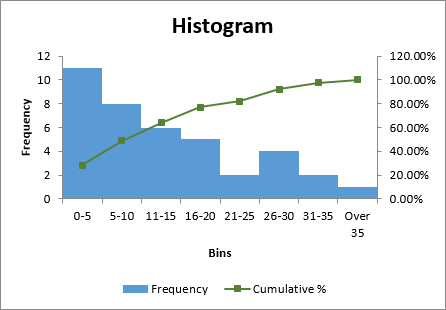

- #EXCEL FOR MAC 2016 MAKE HISTOGRAM CODE#
- #EXCEL FOR MAC 2016 MAKE HISTOGRAM DOWNLOAD#
- #EXCEL FOR MAC 2016 MAKE HISTOGRAM WINDOWS#
Press command+shift+S to save the file, changing the file name.

Right-click within the selected cells to select “Define Name…” for a pop-up dialog.Ĭlick the “+” icon at the lower-left corner to create a name Excel obtained from the first row.ĭouble-click on the name and press command+C to copy the name to your Clipboard:.Manually write down somewhere the row number of the last cell.Ĭlick on the Range Name in the Excel bar, and (if it doesn’t already exist) change it to.If there are blanks in the data, you would need to continue pressing to select the next group.Ĭontinue holding down shift+command with left arrow to select the (empty) C column as well. Click on cell D2 (under the heading) and press shift+command with down arrow to select all the data in that column.We want to end up selecting a section of data spanning two columns (C and D). Press command+~ to switch to the sample spreadsheet. Press command+C to copy the data highlighted to your invisible Clipboard. Click the column heading of the entire column you want to copy.Instructions below to insert your own data: The spreadsheet comes with an alternate set of data, modified from the Histogram-Dynamic.xls Excel file. To display a Histogram of your own data, you would need to change the range name specified in those formulas and focumulas in the Frequency table. The “BinsArray” column contains the upper limit for each step in the Histogram.

Cell F4 displays the minimum values in the same range. Notice it displays the maximum values within the data range named. As the Bin Count changes, different rows are used in the Chart Data box.Ĭlick on cell F5. Notice that when the slider is moved, the Bin Count and Bin Size (B5 and B6) changes,Īs well as data with the “Chart Data” box.
#EXCEL FOR MAC 2016 MAKE HISTOGRAM CODE#
(This spreasheet contains only functions and no VBA macro code which trigger scary messages when loaded.)ĭrag the slider all the way right to see the most number of columns (10 columns), which is a good segmeentation for our base-10 numbering system.ĭata in the sample spreadsheet are ages in a human population, which has a known range of values.Ĭells C4 and C5 (0 and 120) display those minimum and maximum values of bars in the Histogram.īTW, this is why someone around 60 years old is called “Middle Aged”.ĭrag the slider all the way left to see the least number of columns (just 2 columns), which basically divides the population by half according to the range between 0 and 120, which is 60. The Excel sheet is from/described here, based on Jon Peltier’s techniques:Ĭolored cells are where values and formulas are changed for alternate data. It contains a pre-made histogram which you don’t have to construct from scratch.
#EXCEL FOR MAC 2016 MAKE HISTOGRAM DOWNLOAD#
My favorite approach is to change a pre-defined spreadsheet which includes coding to provide a dynamic slider to control how many bins are shown:Ĭlick to download the Histogram-Dynamic.xls Excel file at: Throughout this page are “PROTIP” flags that highlight advice from experience not available elsewhere.

#EXCEL FOR MAC 2016 MAKE HISTOGRAM WINDOWS#
Later on this page are steps to create a Histogram manually in macOS and Windows Excel 2016 and prior versions. Histograms provide a visualization of numerical data.įrequency distributions visualize categorical (text) data.


 0 kommentar(er)
0 kommentar(er)
